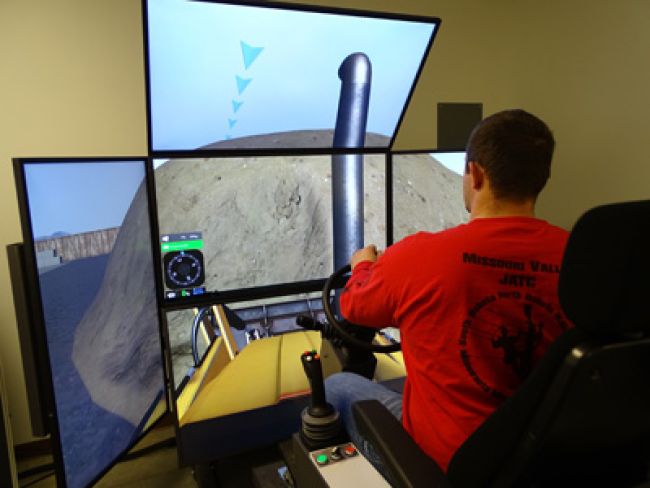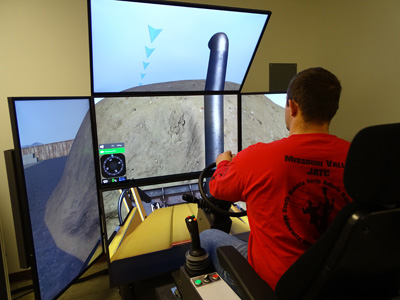
Using Simulators to Standardize Utility Operator Training

The Missouri Valley Line Constructors Apprenticeship and Training Program has supplied a steady stream of qualified workers to the electrical industry of the American Midwest since the mid-1960s.
Operating out of seven locations in Iowa, Minnesota, Missouri, Nebraska, North Dakota, South Dakota and Wisconsin, Missouri Valley Line Constructors has approximately 600 apprentices enrolled in the lineman, traffic signal technician and substation technician programs at any given time.
“We offer a four-year, 7,000-hour apprenticeship program for the power-line industry,” said Robbie Foxen, executive director for the Missouri Valley Line Constructors Apprenticeship and Training Program. “We start from scratch, teaching apprentices how to climb poles, work on transformers, build high-voltage power lines and maintain electrical grids.”
The training center owns two digger derrick trucks, a bucket truck, a skid-steer loader and a boom truck. In the past, with dozens of apprentices vying for time on the machines, scheduling was difficult. “We just hoped they got some hours on the equipment,” Foxen said.
So, to standardize equipment operator training, as well as expand seat time for apprentices, Missouri Valley Line Constructors decided to turn to simulation-based training.
Simulators generally represent a lower cost of investment than real equipment, especially when considering the repair, maintenance and running costs of training novices on real machines. However, beyond cost considerations, simulators offer an attractive training alternative for a number of other reasons.
For example, it is substantially easier to schedule training on simulators, as they are available around the clock and in all climate conditions. In addition, trainees can largely work unsupervised on a simulator, which would not be the case if they were operating the real equipment.
One of the most important advantages of training on simulators over real equipment is that simulators represent a controlled environment for learners to acquire skills. With no extreme temperatures and no competing noise interference, they can focus on gaining the muscle memory required for safe work site operations.
Another key benefit of simulators is that, unlike with real equipment, the machines can log and record a number of key performance indicators, such as duty cycle time, fuel efficiency and shock loads. Such built-in reporting capabilities can provide instructors with a paper trail of trainee progress, as well as an indication of the skills development areas that trainees may need to prioritize.
The Search Begins
After the Missouri Valley Line Constructors Apprenticeship and Training Program staff began their search for simulators online, they soon discovered CM Labs’ Vortex simulators and moved forward with next steps. “We reached out to CM Labs and took a tour of their facility in Montreal, and got some seat time in the simulators,” Foxen said.
CM Labs is by no means the only simulator company on the market, but they were the first simulator company to bring engineering-grade simulation to training schools, meaning that their simulations capture the real behavior of equipment and equipment components, from boom deflection to tire deformation.
The company also was the first to introduce low-cost motion platforms, particularly in contrast to flight simulator motion platforms, which can cost hundreds of thousands of dollars. Motion platforms allow trainees to feel the “seat of the pants” motion they would experience in a real machine. This contributes to muscle memory development and faster learning. For instance, trainees get a sense of how an excavator digs in, or how a crane reacts when a load is set down.
The other innovation CM Labs has brought to the simulator training industry is the ability for organizations to lower their training costs with hot-swappable controls, which allow them to quickly and easily change a simulator’s operating controls without lengthy reboot times and with no need for complex rewiring. In effect, one simulator can give organizations many different training machines.
Making the Investment
Missouri Valley Line Constructors eventually purchased two Vortex Advantage simulators for their training centers, with one housed at their main facility in Indianola, Iowa, and the other located at the training center in Stevens Point, Wisconsin. The Vortex simulators are equipped with backhoe, excavator, rough-terrain crane and boom truck training packs.
“Both simulators have five screens and a full motion package, so the seat moves and vibrates just like when you are running a piece of equipment,” Foxen said. “It feels highly realistic, which helps our students get invested in the scenarios they’re working on. That makes these simulators an extremely effective training tool, as the skills they acquire transfer over to the work site.”
Apprentices in the program spend about one-third of their equipment training time on the simulator and two-thirds on a machine in the field. In addition to field work, apprentices spend about 10 days a year in the classroom, where they now receive roughly five additional hours of training on the simulators.
One notable advantage their trainers have found is that the simulators can track progress throughout the apprenticeship program. “There are four or five different tasks on each piece of equipment that can be assigned to a student to track their progress,” Foxen said. “You can see the results get better and really assess their progress as they spend more time on both the equipment in the field and the simulator in the classroom.
“Beyond the 600 apprentices, we have journeymen upgrade classes that get time on the simulator, too,” Foxen added. “There are between 200 and 300 other individuals who come in and practice, meaning close to 1,000 different operators each year end up using the simulator.”
From a trainer’s perspective, the simulators allow the apprentice to operate in different scenarios. “It makes them more well-rounded, and it also gets them used to operating different pieces of hydraulic equipment,” Foxen said.
A Powerful Tool
Trainers can monitor the student on the simulator directly, standing next to it or watching from any point in the simulated environment from an instructor operating station (IOS). With the ability to introduce challenges, including equipment failure, inclement weather and different times of day, the IOS is a powerful tool that reinforces a high degree of preparedness and attention.
Instructors can use the IOS to track individual performance metrics, and customize scenario scoring in a way that focuses on specific skill development and error avoidance. They can then determine if these errors are common among apprentices and proactively focus on correcting these mistakes.
Training program staff also are seeing an improvement in equipment inspections. “With the simulators, you can make sure they are doing the walkarounds,” Foxen said. “You can simulate a hydraulic hose breaking on an excavator and see if they address the situation right away.” For utilities and contractors looking to hire technicians, apprentices are now better prepared for inspecting and maintaining equipment throughout the day, an additional benefit.
Summary
Overall, simulator training has been a success for Missouri Valley Line Constructors Apprenticeship and Training Program, and trainees are setting up equipment more quickly than before. “It has added a whole other level to training,” Foxen added. “Apprentices thrive with hands-on training. With the simulators, they are learning faster, and the program is turning out better-qualified operators than ever before.”
Simulators will never replace real equipment when it comes to training. However, there is no question that they are instrumental in bridging the training gap that exists between the classroom and real equipment. In particular, instructors can use simulators to replicate the kinds of extreme operating conditions that would be too impractical, expensive or hazardous to replicate in real life. As a result, when the time comes for trainees to step on the job site on day one, they already have a keen understanding of their capabilities and responsibilities.
About the Author: David Clark is content manager at CM Labs Simulations (www.cm-labs.com), developer of Vortex training simulators and CM Labs’ Construction Equipment Training Suite.

